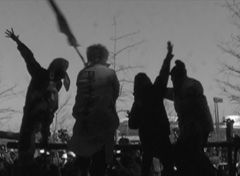Nagai Park Elegy
(“Nagai seishun yoi yume uta”) JAPAN / 2009 / Japanese / Color / Video / 69 min
JAPAN / 2009 / Japanese / Color / Video / 69 min
Director, Photography, Editing: Sato Leo, NDS
Camera Support: Chang Yonte, Kojima Fusako, Nakamura Yoko, Nunokawa Tetsuro
Sound Editing: Urata Haruo, Ichikawa Kazutaka
Music: Arichikoku
Producer: NDS (Nakazaki-cho Documentary Space)
Source: Kawahito Rie
The opening of the 2007 Osaka World Championships in Athletics draws near, and the eviction of the homeless from Nagai Park begins. Diverse views of the homeless who want to continue mounting plays in the park, and those of their supporters interact with the director’s gaze. The camera captures protest “actions” in the park and on the streets. The final curtain rises and the “play” begins. “All the world's a stage, and all the men and women merely players.” The cast: 500 city government security guards, the media, the spectators, the supporters, the homeless, and the filmmakers.
[Director’s Statement] “On February 5, 2007, Nagai Park Tent Village performed a play as the tents were being torn down.”
All that the film tries to convey is summarized in this one sentence. By around noon that day, Nagai Tent Village was gone without a trace, as if there’d been nothing there. But it’s certain that something else is spreading.
A year before, I had filmed tents being torn down during a forced eviction at Utsubo and Osaka Castle parks, also in Osaka.
With tents being toppled around me, I had felt nothing. I just kept rolling the camera, not knowing whose tent it was that was being demolished. I had looked on incredulously as people screamed in anger even though it wasn’t their tent being torn down.
Six months later, I learned that Nagai Park Tent Village dwellers had been ordered to leave. Everyone knew that sooner or later a forced eviction would take place.
I decided that I didn’t want to shoot footage without feeling anything, as I’d done the year before. I went to live in the tent village myself and began shooting.
How hard it was to live in a tent at a park! How much harder to live on the street: The contemptuous way people looked at the homeless. Something like a community had formed at Nagai Tent Village, and individuals bonded together. Some young people my age had gathered there too. Some were barely hanging onto life. Despite the uncertainty of not knowing when the tents might be demolished, I got to know the people at Nagai Tent Village better, and was beginning to half enjoy the life there.
But I had come there in anticipation of the moment when the tents were destroyed—to film people infuriated, crying, screaming, as their tents were torn down.
And they knew better than I did what I had come to the park for.
 Sato Leo, NDS (Front row center)
Sato Leo, NDS (Front row center) Born in Kyoto in 1981. Sato began filming Nagai Park Elegy in November 2006 and completed the film in May 2009. Since around August 2007, he has developed his skills through an ongoing workshop with other aspiring documentary filmmakers in the Osaka area, who criticize each other’s works-in-progress, while studying the documentaries, fiction films, and experimental films of their predecessors. He is in the process of forming a documentary filmmaking group, Nakazaki-cho Documentary Space (NDS), with Chang Yonte (director of The Tale of Nakamura), Kajii Hiroshi, Nakamura Yoko, Kim Imman, Nunokawa Tetsuro and others. He currently lives in Amagasaki, near Osaka. |
